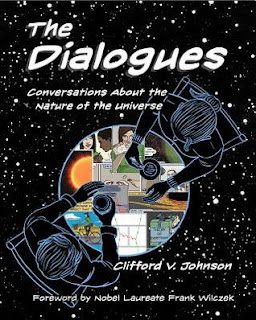The Dialogues poses an interesting idea: what if we incorporated science into our daily conversations the way we do politics, sports, or movies/tv shows? What would our world be like if we discussed our questions or unknowns? What if every scientist believed those outside the field were interested (and capable!) of having discussions around science?
Science can feel exclusive but The Dialogues finds a way to bring it to the lay person. Swipe to see my favorite panel, featuring two youth going through the scientific method (without even knowing it!). Their curiosity came from a meal they were eating.
Last year, we went to #SVCC, which featured a partnership with #NASA. I didn’t go to a con expecting to want to spend the entire weekend in science panels but once we engaged with NASA scientists, we couldn’t resist spending our weekend learning more. My preferred science has always been biology (my original major!) but I was way into the astrophysics being presented. The Dialogues reminded me of this experience!
I loved that the author/illustrator designed a graphic novel versus a print story (show, not tell). I also appreciated the explanations at the end of the chapter, which provided insight and further reading opportunities.
Highly recommend for everyone to plant the seed of adding science to your day! Take that curiosity into your daily conversations and watch yourself turn into a scientist! Check out my interview with Dr. Clifford Johnson below!
Interview w/ Dr. Clifford Johnson, Author of The Dialogues
You wrote and illustrated The Dialogues. What was your creative process like in designing both the story and the art?
Well, I used many different modes along the way. Sometimes I’d write dialogue on its own mostly, with relatively little attention to the art aspect, but at other times I wrote much more visually, doing little thumbnail versions of the page as I thought about the concepts being discussed, constructing the words of the dialogues for it later. Other times – most times – it was more a little of both, where design of the words, settings, layout, and other aspects were done in parallel, ensuring that they all support each other, as I hope you can see in the book! Of course, I was also learning the whole process as I was going along, spending a lot of time learning drawing and the right kind of art and other techniques needed to make a graphic book.
In The Dialogues, you share instances in which people could weave science into their daily conversations. Have you eavesdropped on any convos? Tell us about them!
Well, the book is me telling you about them! The whole book is a celebration of such conversations about science between ordinary people out there in the world. Not particular conversation in there is fully an overheard conversation, but most of them have elements that contain the spirit of real conversations I’ve heard out there in the world about Science. Listen and you’ll hear some too.
I love how you list resources after each chapter to help add to the conversation or build on natural curiosity. Are there general resources you’d recommend to people who are interested in learning more about a specific scientific subject?
Well, it depends upon your interests. The best general sources remain your local library and your local bookstore, especially if you’re not sure what you’re looking for exactly. No, seriously, go and browse and find some surprises to take home, and if they don’t have the kinds of things you’re looking for, make suggestions. Browsing books on a shelf is becoming a forgotten art, but it can’t be beat. Of course, there’s the web, but most good sources are typically narrowly separated out by category, so you maybe already know what you’re interested in before you begin looking. But there are exceptions: Cara Santa Maria’s podcast Talk Nerdy has lots of great guests on lots of diverse topics, maybe leading you to discover topics you did not know you were looking for. Another great resource like that is Maria Popova’s Brain Pickings, a website full of great book and other recommendations on science and well beyond. Radio programs like Science Friday and The Pulse in the USA have excellent companion websites, and pretty much any of the BBC’s several science programs on Radio have great companion websites, podcasts, etc. And of course there are great bloggers like the team at NPR’s Cosmos and Culture blog or Phil Plait’s Bad Astronomy that are worth checking periodically.
What are some of the comics that inspired you to want to write and illustrate your own graphic novel?
You might be expecting me to list other examples that talk about science, but I’m unable to since one of the reasons I made this book is because I saw a need for it – I could not see anything out there like it. So I just decided to make it to show it can be done and to encourage others to maybe try too. The point is that I wanted a graphic book that has science as a starring character, but wasn’t an illustrated lecture. Illustrated lectures are awesome but not what I was going for, and most graphic books which aren’t that are instead biographies of scientists. Another great genre, but also not what I wanted to do. So I was trying to do a non-fiction book, with a serious tone, about science, for grownups (although younger people can read it too!) who appreciate that the graphic novel form can contain more than just superheroes, or jokes, or adventure stories. So I’m still struggling to find you examples that inspired me. I can’t. It is probably because I did not start thinking about combining graphic books and science for the sake of experiment, but instead because I was driven to it a solution to an idea I had back in 1999 while thinking about what was missing in standard prose books about science. I wanted to have conversations up front, and then I realised I wanted readers to see the people more, and what they were saying and maybe writing, and the locations of the conversations. These were all important elements to me as a means of making the reader feel more included in the process of the science discussion. It dawned on me in the mid 2000s that the solution was to go graphic. I was then blown away that nobody had ever really done that before. So I kind of had to make it.
Once I was well on the path with the book, however, some interesting graphic books started to appear that you an imagine being on the same part of the bookshelf as mine, like Logicomix (although that is still mostly biography, but has mathematical ideas very upfront), or Nick Sousanis’ Unflattening, which examines ideas about visual perception and representation. I humbly submit that I’d hope on that shelf could be David Mazzucchelli’s masterpiece Asterios Polyp, which is actually a novel, but somehow has architectural ideas and sensibility very much at the forefront… or even Sonny Liew’s masterpiece from last year, The Art of Charlie Chan Hock Chye, which is a wonderful way of exploring the history of a country in detail (and also aspects of the history of comics), while masquerading as a biography.
Tell us about your journey to becoming a physicist. What moments have been defining for you in your career?
I actually wanted to be a scientist since I was a young child (well before 8 or 9), I think because I learned that there was this career where you could just continue asking questions and figuring out how stuff worked, which is what I liked to do anyway. I was flummoxed when one day a family friend asked what kind of scientist I wanted to be. I didn’t know you had to choose, and I remember finding this revelation annoying. So I went away and sat with a dictionary and looked up every “-ist” and “-ologist” I could find until I hit “physicist”. The definition said something about it being the field which underlies all the other scientific fields. That was it for me. I loved (and still love) all of science, and so a definition like that (which of course is really oversimplified and arguably wrong) was music to my ears since it meant I could keep my options open about what science I got involved in. So that was a defining moment. There were many others along the way, and many obstacles too, but I’ve always been pretty determined, cared little about some people thinking that it was (for some) an odd choice, and so stayed hooked and kept on the path. Frankly, having a family that was supportive of my choices even if they couldn’t always relate to them was super-important.
by Dr. Clifford Johnson
Published: November 16th, 2017
Publisher: Mit Press
Source: Publisher
A series of conversations about science in graphic form, on subjects that range from the science of cooking to the multiverse.
Physicist Clifford Johnson thinks that we should have more conversations about science. Science should be on our daily conversation menu, along with topics like politics, books, sports, or the latest prestige cable drama. Conversations about science, he tells us, shouldn’t be left to the experts. In The Dialogues, Johnson invites us to eavesdrop on a series of nine conversations, in graphic-novel form — written and drawn by Johnson — about “the nature of the universe.” The conversations take place all over the world, in museums, on trains, in restaurants, in what may or may not be Freud’s favorite coffeehouse. The conversationalists are men, women, children, experts, and amateur science buffs. The topics of their conversations range from the science of cooking to the multiverse and string theory. The graphic form is especially suited for physics; one drawing can show what it would take many words to explain.
In the first conversation, a couple meets at a costume party; they speculate about a scientist with superhero powers who doesn’t use them to fight crime but to do more science, and they discuss what it means to have a “beautiful equation” in science. Their conversation spills into another chapter (“Hold on, you haven’t told me about light yet”), and in a third chapter they exchange phone numbers. Another couple meets on a train and discusses immortality, time, black holes, and religion. A brother and sister experiment with a grain of rice. Two women sit in a sunny courtyard and discuss the multiverse, quantum gravity, and the anthropic principle. After reading these conversations, we are ready to start our own.

